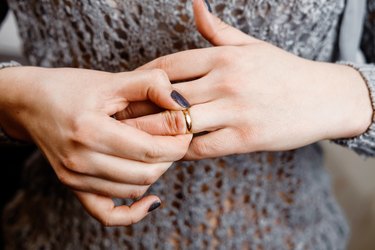
When you're trying to lose weight, there are certain areas on your body that you might want to trim down. Losing weight in the fingers might not be your goal, but it could happen. When it does, it can change your ring size.
Tip
Your fingers may shrink when you lose weight. This is because there are stores of fat underneath the skin.
Video of the Day
Most effects of exercise are beneficial for your health. The U.S. National Library of Medicine explains that working out may protect against heart disease, help you quit smoking, improve mental health and deepen your sleep. That's not even the full list.
Video of the Day
Given all the positives associated with exercise, it's hard to imagine any negatives. One you may not expect is that your fingers may slightly shrink. If you have a wedding or an engagement right, there's a chance that it will no longer fit after you lose weight.
Fat Storage in the Body
When you lose weight, your fat cells shrink. Where you burn fat depends on genetics and fat distribution — you don't get to choose where the fat comes from.
Unfortunately, there is no way to lose fat from a specific area, such as your abs or arms. Spot reduction is just a myth. As the American Council on Exercise points out, workouts that target specific areas of the body won't cause you to lose fat from those body parts alone.
The proper name for fat is "adipose tissue." There are two types of adipose tissue in your body: white and brown. White adipose tissue (WAT) is the most abundant and accounts for over 95 percent of fat mass, according to an October 2019 review published in the Journal of Clinical Investigation. There are various uses for the fat in your body.
Visceral fat, a type of WAT, wraps around your organs and provides a layer of cushioning. However, too much of it can be harmful to your health and increase the risk of cardiometabolic diseases. Subcutaneous fat sits underneath the skin and keeps you warm, according to the AARP. It also serves as a source of energy for your body.
Fat is useful for storing energy as it provides two times more calories per gram compared to an equal volume of carbs or protein, states the University of Maryland. It also helps your body absorb vitamins A, D, E and K.
Losing Weight in the Fingers
Losing weight in the fingers might seem strange, but it can happen. Similar to in your heel or knee, there are fat pads under your fingers that provide cushioning. These little deposits of fat tissue protect the bones and ligaments in your fingers. They are structurally similar to white adipose tissue, according to a March 2018 study published in Frontiers in Veterinary Science.
The fat in your fingers doesn't get as much blood flow as, say, the fat in your arms. It's located there for protection, but the more fat you lose, the higher the odds of losing weight in the fingers.
Fat loss occurs when you're in a negative energy balance, according to the National Heart, Lung and Blood Institute. That means you're burning more energy than you take in through your diet. By eating less to reduce your energy intake while exercising to burn more calories, you can tip the scales of energy balance and start to burn fat.
Read more: What Is a Hypocaloric Diet?
Resizing Your Ring
After a period of weight loss, your ring size might be smaller. Fortunately, a jeweler can take your finger measurements and shrink the ring to your new size.
According to the Gemological Institute of America, your new ring should be able to pass over your two finger joints. It should fit snugly on the finger, and the stone (if the ring has one) should stay on top without tipping to either side.
With your new ring size, you can have a jeweler shrink the ring for you so that you don't have to buy something new. There are several methods of resizing, according to the Jewelers of America.
One option is to cut a section out of the bottom of the ring and solder the ends together. You can also use spring inserts that can hug the finger and are able to shrink the ring one or two sizes. Just because your fingers are smaller doesn't mean that all hope of wearing your ring is lost.
- Jewelers of America: "Jewelry Repair Guide"
- Gemological Institute of America: "Accurate Determination of Finger and Ring Sizes"
- National Heart, Lung and Blood Institute: "Balance Food and Activity"
- University of Maryland Extension: "Fats: A Concentrated Energy Source"
- The Journal of Clinical Investigation: "Altered Adipose Tissue and Adipocyte Function in the Pathogenesis of Metabolic Syndrome"
- American Council on Exercise: "Myths and Misconceptions: Spot Reduction and Feeling the Burn"
- U.S. National Library of Medicine: "Benefits of Exercise"
- AARP: "The Health Benefits of Fat"
- Frontiers in Veterinary Science: "The Unexplored Role of Intra-articular Adipose Tissue in the Homeostasis and Pathology of Articular Joints"